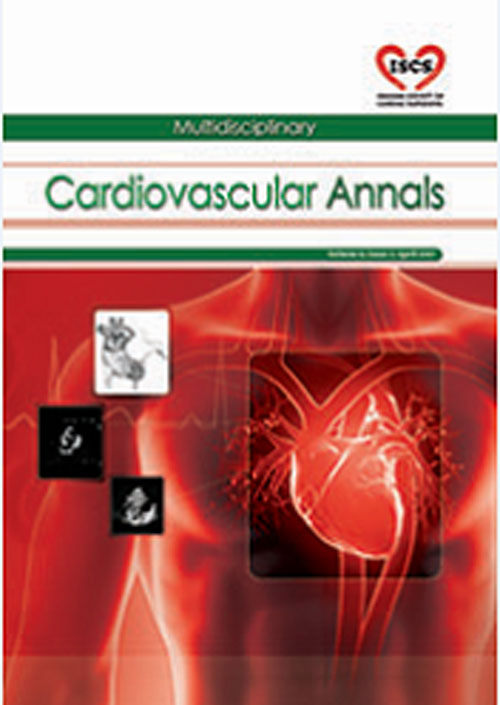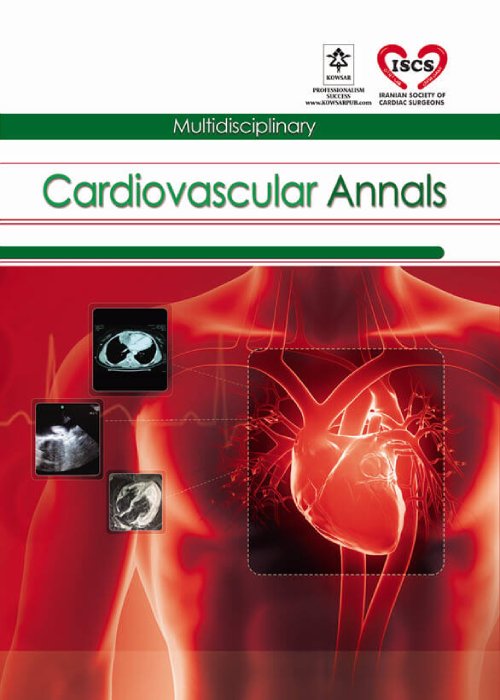فهرست مطالب

Multidisciplinary Cardiovascular Annals
Volume:11 Issue: 2, Jul 2020
- تاریخ انتشار: 1399/05/15
- تعداد عناوین: 8
-
-
Page 1Objectives
The goal of this practice was to explore whether the changes in arrhythmias after uvulopalatopharyngoplasty (UPPP) in patients with moderate obstructive sleep apnea syndrome (OSAS) who continued cardiac arrhythmias despite the use of antiarrhythmic drugs and those who could not tolerate the continuous positive airway pressure (CPAP) device. In addition, we evaluated the correlation between arrhythmias before and after UPPP.
MethodsThis retrospective study included patients who have OSAS and cardiac arrhythmias, between 2008 - 2017 by the cardiology clinic and consulted by the ear, nose, and throat (ENT) clinic. Thirty eight patients were selected and underwent UPPP operation. The rhythm Holter follow-ups of the patients in the 1st month before UPPP (pre-UPPP) and after UPPP (post-UPPP) 6th month were performed. The recordings were transferred to the computer and evaluated with the Holter program, then visually examined and the parasitic regions were excluded. Sinus bradycardia (SB), atrioventricular block (AVB), atrial premature beat (APB), supraventricular tachycardia (SVT), and ventricular extrasystole (VES) parameters were recorded for arrhythmia.
ResultsStatistically significant differences were observed in the changes in SB, AVB, APB, SVT and VE arrhythmia values in pre-UPPP and post-UPPP periods. Also, in one case the values of arrhythmia in the pre-UPPP period had a positive correlation with the values of the same arrhythmia in the post-UPPP period (P < 0.001).
ConclusionsIn this study, new information about the effects of UPPP which is one of OSAS treatment methods on cardiac arrhythmias is presented. According to our results, UPPP reduces the rate of SB, AVB, APB, SVT and VES arrhythmias in OSAS patients.
Keywords: Cardiac Arrhythmias, Obstructive Sleep Apnea Syndrome, Uvulopalatopharyngoplasty -
Page 2Background
Human epidermal growth factor receptor 2(HER2) is a gene that makes proteins in the breast cell. The HER2 gene is present in about 25% - 30% of patients with breast cancers. The most common side effect of drugs is left ventricular dysfunction. Evaluation of left ventricular ejection fraction (LVEF) by 2D echocardiography cannot detect subtle changes in LV systolic function.
ObjectivesWe want to draw a comparison between two groups of breast cancer patients (HER2 positive and negative) by advanced echocardiography.
MethodsWe have conducted a single center prospective study at Rajaie Cardiovascular Medical and Research Center in 2018 - 2019.
ResultsThis analysis included 58 patients with breast cancer. 15 cases (34%) were HER2 positive. Mean left ventricular ejection fraction (2D LVEF) in HER2 positive patients was 55 % at baseline and in HER2 negative patients was 55 %. In HER2 positive patients we had 10 percent decrease in LVEF during follow-up and the final LVEF was about 45% (P value < 0.05). Mean left ventricular ejection fraction by 3D echocardiography (3D LVEF) in HER positive patients was 57 % and in HER2 negative patients was 55 % at baseline. In HER2 positive patients we had about 20% decrease in 3D LVEF and the final LVEF was 40 % (P value < 0.05). Mean circumferential strain (GCS) in HER2 positive patients was -21 and in HER2 negative patients was -21 at baseline which decreased to -18 in HER positive patients and -17 in HER2 negative patients, showing clinical significance ( P value = 0.008).
ConclusionsIn our study HER2 positive breast cancers showed about 10% drop in 2DEF, about 20% drop in 3DLVEF and about 5% drop in HMLVEF, which all were significant (P value < 0.05). We found that GCS is more sensitive than GLS in detecting subclinical involvement, and early changes in GCS is a good predictor of subsequent development of drugs (anthracycline-transtuzumab) induced cardiotoxicity.
Keywords: Breast Cancer, HER2 Gene, Echocardiography, 3D Echocardiography, Cardiac Function -
Page 3Background
Among acute coronary patients, the ratio of non ST-elevation myocardial infarction (NSTEMI) is increasing and according to recent studies, less than 30% of myocardial infarctions (MIs) are due to ST-elevation myocardial infarction (STEMI). Unlike STEMI, in NSTEMI the ECG is not able to identify the culprit vessel.
ObjectivesIn this study, we aimed to evaluate the association of mean platelet volume (MPV) and NSTEMI due to left anterior descending lesion.
MethodsIn this cross sectional study 349 patients with NSTEMI were included. Major cardiac risk factors (cigarette, diabetes mellitus (DM), hypertension (HTN), hyperlipidemia (HLP), angiographic findings, and drug history of patients were extracted from patients’ medical files. Then the MPV in complete blood count results and angiography findings were analyzed for any association. According to culprit lesions patients were divided into left anterior descending (LAD) and non-LAD groups.
ResultsThere was a significant difference between the two groups (LAD vs. non-LAD) according to platelet count (P = 0.014), MPV (P = 0.001), HLP (0.024) and DM (0.048). Multivariate regression model has shown the MPV (OR = 0.46, 95%CI = 0.27 - 0.78) and DM (OR = 0.18, 95%CI = 0.06 - 0.54) as independent risk factors for NSTEMI due to LAD lesion. The significant positive correlation was also seen between MPV and left ventricle ejection fraction (LVEF) (r = 0.22, P = 0.006). The area under the curve (AUC) of MPV for predicting LAD culprit lesion was calculated as 69% (P < 0.0001). At cut off point of 9.15, has sensitivity and specificity of MPV for predicting LAD as culprit vessel was 100% and 30% respectively.
ConclusionsIn NSTEMI patients MPV might be a good tool to differentiate patients with LAD as culprit vessel.
Keywords: MPV, NSTEMI, LAD, Culprit Vessel -
Page 4Background
Cardiopulmonary resuscitation (CPR) has been a frequently performed medical intervention that increases the chance of survival of a person stricken by cardiac arrest, and there is an excellent value of diversity in the rate of successful rehabilitation in societies.
MethodsA retrospective observational study was carried out. The medical records of all in-hospital and out-hospital cardiac arrest patients who underwent CPR were collected. A total of 587 people with who underwent CPR during two years between January 2017 and June 2018, using a designed form were enrolled. Demographic information, the ward which CPR was committed, hospitalization, the delay before the onset of CPR and time of the day were recorded.
ResultsThe overall success rate of CPR in this study was 25.89%. There was no significant difference in the success rate of CPR between men and women. A comparison of age groups revealed a difference between the success rates of CPR in 14 - 64 years group compared with the group above 64. Analysis of the data revealed no difference between CPR success rates in various seasons. Investigating the occurrence of cardiac arrest and its success rate at the hospital shifting showed a significant difference between the success rate of CPR in the morning shift with the evening shift and night. The dual comparison revealed a significant difference in the success rate of CPR only between the emergency department and intensive care units.
ConclusionsThe current study revealed a significant difference in age group and location, and did not show any significant success rate of CPR in the presence of witnesses, location of cardiac arrest, season and gender.
Keywords: Cardiac Arrest, Cardiopulmonary Resuscitation, Hospitalized Patients -
Page 5
Anomalous origin of the right coronary artery originating from the pulmonary trunk (ARCAPA) is a rare congenital coronary anomaly with wide spectrum of clinical outcome. We are presenting a case of ARCAPA with a review of the previous studies about it.
Keywords: Atypical Chest Pain, ARCAPA, Coronary Origin Abnormality -
Page 6
Myocardial infarction (MI) is the most frequent cause of ischemic heart death. MI is generally assumed to be due to arterial thrombosis superimposed on an atherosclerotic plaque in an epicardial coronary artery. Total occlusion of an epicardial coronary artery leads to ST elevation, while non-occlusive lesion leads to ST depression. We hereby have reported a case of ST-segment elevation myocardial infarction with normal coronary arteries angiography. A 35-year-old man presented with typical chest pain, nausea, vomiting and cold sweating. ECG obtained at admission and 30 minutes later revealed sinus tachycardia with ST-segment elevations (> 2 mm) in leads V2-V5. Cardiac biomarkers including creatine phosphokinase (CPK), creatine kinase muscle-brain (CK.MB) and troponin high sensitive were elevated. The standard treatment for MI including pain relief, aspirin, thrombolysis if indicated and beta blockade were begun for the patient. STEMI was confirmed and thus, angiography was performed. Coronary angiography revealed normal coronary arteries without any angiographic evidence of stenosis, coronary artery dissection, embolism, plaque rupture or vasospasm.
Keywords: Acute Myocardial Infarction, Normal Coronary Angiography, ST-Segment Elevation -
Page 7
The bi-monthly meeting of the Iranian society of cardiac surgeon (ISCS) has been held regularly since 2005. The first ISCS bi-monthly virtual meeting was held in May 2020 during the COVID-19 outbreak. We have briefly reported the content of this virtual meeting in this article.
Keywords: Endocarditis, CABG, MAC, Perceval S, Covid-19, Meeting Report, MV Repair, Valve Thrombosis, Tricupid Valve


